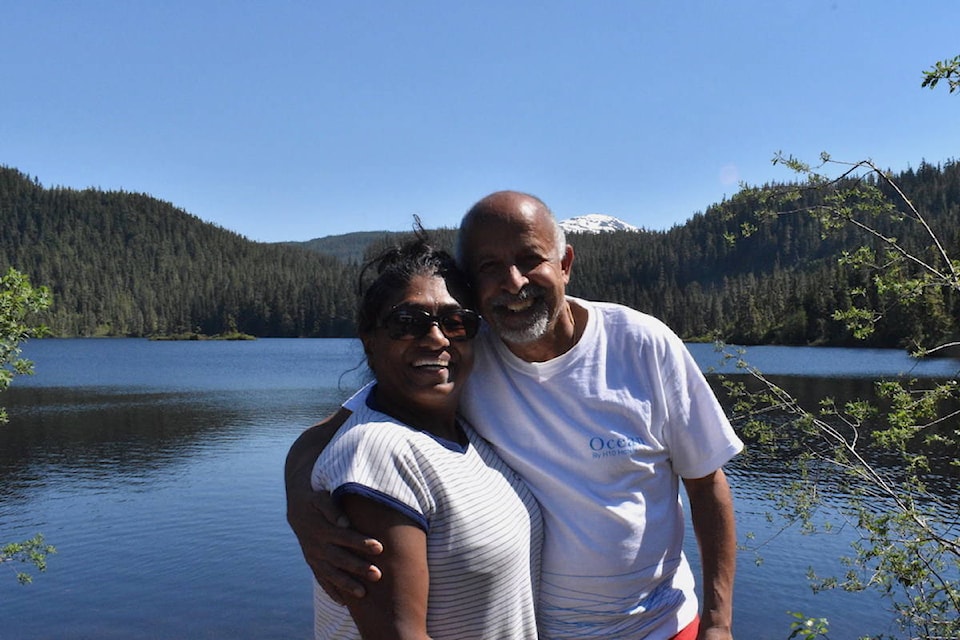Indhu and K.U. (Mathew) Mathew have one of the most enviable jobs in northwest B.C. Far from the madding crowd, they manage Kitsault – an abandoned town that has captured the fancy of most who have heard about its history and its equally intriguing contemporary state.
“We have the best job on earth,” said 70-year-old Mathew before providing a glimpse into their lives in Kitsault.
Tucked along the coast of the Observatory Inlet, 115 kilometers northwest of Terrace, the former mining town’s story is closely linked to the rise and fall of molybdenum. Kitsault was built in the late 1970s – complete with a state-of-the-art recreation centre, hospital and mall among other amenities – to house over 1,200 residents. However, the town was barely inhabited before the price of “moly’ crashed and the mine shut down.
The town was later bought by Indo-Canadian businessman Krishnan Suthanthiran in 2005.
Around that time Mathew and Indhu, both teachers, were based in Terrace after a stint of having taught in India and the Middle East.
When they were entrusted with the job of looking after Kitsault, Indhu and Mathew both look back fondly of how they were least prepared to accept it.
This is a story Indhu tells visitors when they arrive in Kitsault. In India – where the couple spent their early years – there’s domestic help available to carry out most of the chores.
So fixing things, using a weed wacker or lawn mowers was not exactly something with which they were accustomed. Better put in the words of Mathew – “When Krish offered me the job, I told him I didn’t know anything when it came to the skills required to maintain a town.”
The couple were based in Terrace until six years ago when they retired and relocated to Vancouver Island.
Mathew taught mathematics in schools in Kitimat and Terrace as well as for several First Nations’ trades programs. He said that was a part of his agreement with Suthanthiran when they took the job, that he would continue to teach.
They live in Kitsault from May to October and then head back home, leaving the reins to the caretaker in winter. But they keep in close contact regarding what may be needed.
While they are in town, there’s always something to do, said Mathew. Which makes perfect sense considering the fact that the town is impeccably preserved in time and well maintained.
A typical day in Kitsault begins at 8 a.m. with staff reporting for duty. Indhu assigns task sheets and supervises the work. Houses are re-roofed, lawns are mowed and the insides of each building is cleaned to ensure there is no mold or cracks.
“We have a very reliable and good crew and are like family to us,” said Mathew. The crew work for 10 days on site and head out to the nearest town, Terrace, for a four-day holiday.
“Kitsault is a beautiful town to live in,” he said.
Maintaining Kitsault in its current glory is an expensive feat and the owner spends anywhere from $500,000 to $3 million a year based on what’s required. One time, a 56-foot roof had to be flown in from Vancouver, another time the underground water systems had to be changed.
“So there’s always something to do,” said Mathew about their stay in Kitsault during the summer. While they’re not fixing the place, they’re exploring the wilderness surrounding them and they sometimes come across rare treasures.
One such find is the quaint tea house near the dock that overlooks the fjord. They found it in the forest and relocated it to the dock side. “We like to keep things pretty here,” said Mathew.
They get numerous calls from people who want to visit Kitsault. However, Mathew and Indhu do not entertain most requests and said that they like to keep the town locked as Kitsault is a private space and the owner is not too keen on opening it to visitors.
But some visitors are allowed because of their long time association with the University of Northern British Columbia and its program coordinator, Rob Bryce, who also conducts ghost town tours to the neighbouring towns of Alice Arm and Anyox.
While Kitsault is clumped together with these towns, which were also former mining towns and are also abandoned, Mathew does not like to qualify Kitsault as a ghost town. There’s some level of activity that goes on inside Kitsault as it sees small groups of mining and environmental companies pass by occasionally.
Kitsault is being maintained by its owner Suthanthiran who has plans to make it an export terminus for pipelines from the northeastern B.C. oil and gas fields. They would carry natural gas, crude oil and butanol for transport to Asian markets.
While those plans have yet to materialize, Kitsault continues to be cared for by Indhu and Mathew, who make sure that the time loop reflecting its former glory is not broken.
“We treat Kitsault as our property while caring for it and we want to be diligent and faithful to the boss who has entrusted this place in our care,” said Mathew.
